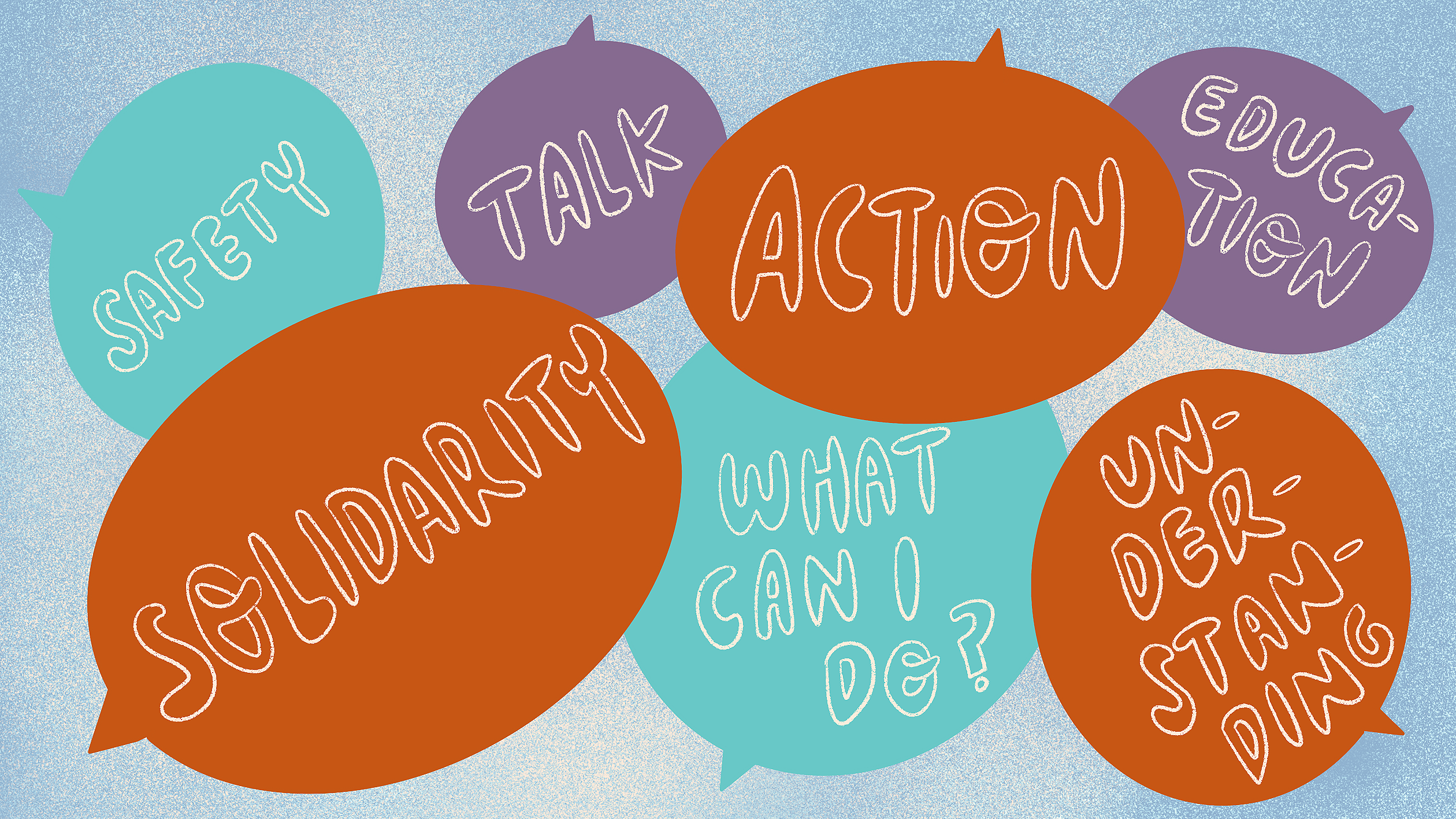
Illustration by Daniela Nunes
Human rights education and (armed) conflict
by Dariusz Grzemny
Is human rights education needed in a time of war? What can it offer to young people affected by war or other young people who feel lost in this difficult situation? How can it be used in youth work outside Ukraine, especially in countries that host a great number of war refugees? These are not easy questions. The answer is that human rights education can do much, though not everything.
Human rights education has always had a prominent role in the youth sector of the Council of Europe. Thanks to the Human Rights Education Youth Programme, numerous training activities, youth campaigns and educational resources, such as “Compass”, human rights education has been mainstreamed in youth work across Europe and beyond. In one of the episodes of the Under 30’ podcast of the Youth Partnership we have learnt from the youth workers who work in Ukraine that human rights education programmes and activities are being provided to young people in youth centres during the time of war. Human rights education was also mainstreamed in various youth projects organised within the Erasmus+ programme of the European Union. A network of national Erasmus+ agencies developed policy recommendations on mainstreaming human rights education in the field of youth within the Youth for Human Rights project.
Both the Universal Declaration of Human Rights and the European Convention on Human Rights were drafted after the Second World War to safeguard fundamental rights and freedoms, to protect the people from the state and to make sure the atrocities committed would never be repeated. It is believed that human rights “are the foundation of justice and peace in the world and are best maintained on the one hand by an effective political democracy and on the other by a common understanding and observance of the Human Rights upon which they depend” (Preamble to the European Convention on Human Rights). The Convention is an important instrument from which individuals, non-governmental organisations or groups of individuals can benefit if their human rights are violated by a state party to the Convention.
During war, various human rights are violated, for example the right to live, right to a fair trial, right to safety and security of the person, freedom from torture and inhuman or degrading treatment, freedom of assembly and association, right to education, right to work, right to health, right to property, etc. Most importantly, there is the right to peace, reaffirmed in the Declaration on the Right to Peace adopted by the UN General Assembly on 19 December 2016.
 The right to human rights education
The right to human rights education
If human rights are to be promoted and protected, people need to know about them, they need to understand them and have the skills to effectively claim them.
The general goal of all human rights education initiatives is to integrate international human rights standards and practices into people’s daily lives. It is to create a culture of human rights, in which the human rights of all people are protected. Therefore, human rights education is often linked with programmes on conflict resolution, intercultural learning, civic education or democracy education.
As stated before, war curbs the right to education, including the right to human rights education. Many young people in Ukraine were displaced and for some time fell out of the education system and youth work activities. Schools and youth centres were destroyed or severely damaged. Many youth workers got conscripted and therefore they were not able to run youth activities. Some youth centres were turned into humanitarian aid centres and young people were involved in developing equipment for the army, such as military camouflage nets. Some facilities cannot effectively provide youth services as their work is constantly interrupted by the alarms that force people to go to the shelters. However, there are still many places where young people can benefit from human rights education.
Everyone has the right to human rights education. The Council of Europe Charter on Education for Democratic Citizenship and Human Rights Education recommends that member states in the framing of their policies, legislation and practice should make sure that education for democratic citizenship and human rights education is provided to every person within their territory. It also recognises the role of youth organisations, which have “a valuable contribution to make to education for democratic citizenship and human rights education, particularly through non-formal and informal education, and accordingly need opportunities and support in order to make this contribution” (Council of Europe Charter on Education for Democratic Citizenship and Human Rights Education).
 Human rights education in a time of war
Human rights education in a time of war
There are probably many more important things to do than human rights education when there is war in a country. People need to make sure they are safe, that their family is safe, there is enough food to eat, there is water, they have a place to stay, and they have money to survive. These are human needs. Human rights are behind human needs and it is always the responsibility of the state to make sure these rights are guaranteed and that they are not violated. We very often realise we have human rights when we feel they are being violated. Human rights education will not end the war and it will not solve most of the challenges the war is causing. However, it can support young people and youth organisations in many ways:
It can provide a (relative) sense of stability and safety
Many youth organisations, including those in Ukraine, have implemented human rights education programmes over the last years. Compass: manual for human rights education with young people is available in Ukrainian, just like Bookmarks: a manual for combating hate speech through human rights education. Human rights education has become an important element of youth work provided in Ukraine and both youth workers and young people have got used to it. Human rights education is based on the needs and experiences of young people; it starts where young people are, so it is very contextualised. It can, therefore, try to respond to the specific needs young people may have as a result of war. Using this approach can create a sense of safety for young people as they would be participating in a process they know well. It would also guarantee relative stability to youth work services as they would not be urged to look for extraordinary solutions in the work they do but rather adapt the existing model to a given situation.
It can provide a framework to understand existing complexities
Discussing war can be hard. What is more, it can result in reinforcing stereotypes and prejudice and lead to drawing conclusions that are based on feelings emerging in a difficult situation, which can often be deceiving. War is a complex thing – it is a mixture of different elements: political, economic and legal, together with personal experiences. It is difficult to understand them all, so in the end what counts is personal experience, as this is something we can more or less easily refer to. The war in Ukraine and its consequences are also discussed in youth work activities in other countries, especially the ones that border with Ukraine and became a home for millions of war refugees from Ukraine.
Human rights education can help in understanding those complexities. Effective human rights education should take into account three dimensions. Knowledge and understanding is only one of them. Skills is the next, such as the ability to recognise human rights violations or skills related to documenting war crimes. And then, there are values and attitudes, such as commitment to fairness and equal treatment, non-discrimination, and a willingness to support others. That is why it is often said that human rights must be holistic and address cognitive, behavioural and attitudinal aspects.
Discussing issues related to conflict and war can be challenging, and sometimes end up badly. Human rights education can provide a framework to support this endeavour. It grounds the discussion in people’s actual lived experiences and connects them with concrete human rights fitting within the discussion. What is needed here are the right methods that should be used. The relationship between the learning situation and the real life of the learners, and especially the latter’s perception of this relationship, must be reflected in the methods chosen. The existing manuals on human rights education can be an inspiration for deciding on the method suitable for the given context. They will often need to be adapted to the needs of young people; sometimes a simple activity or facilitated group discussion can be the most effective.
It can encourage taking action
An educational activity is usually never enough. What makes human rights education relevant in a conflict situation is that it should end up with action that is meaningful for learners. It is them who decide what they would like to undertake as a result of an activity. The question “what can I do now?” is often voiced by young people who discuss conflict, whether they face it directly or not. Human rights education can help young people come up with ideas that make sense to them and would be realistic and doable. For example, getting to know the needs of the young people in the neighbourhood in terms of access to food or shelter, organising support for those who miss out on school, learning how young war refugees can be best supported in school, etc.
It can develop solidarity
Solidarity with those whose rights are violated is one of the values that human rights education should be based on and should promote. We saw it and still see it in Ukraine and many other countries, in which millions of people (especially young people) in solidarity with people affected by the war got involved in many solidarity actions, like collecting food or other essential products, organising housing, helping with learning the language of the new place, or organising mental health support. Human rights education should aim at strengthening the value of solidarity in people and support them in making it practical, so it is sustained and leads to providing help to those who need it.
Human rights education has proven to be an effective tool in youth work in helping young people to make sense of the reality that surrounds them. It also creates a safe space for people where the voices of all can be heard and where values can be negotiated. It does not provide all the answers but rather creates new questions, which can be discussed.
Human rights education has its limits and may not be the right tool to be used in some situations. But in hard times, such as war, things like human relationships, developing a sense of urgency and readiness to take action, feeling safe and appreciated, and understanding what is happening around us are essential. Human rights education can do it, or at least it can try.
One of the biggest aims of human rights education is to prevent conflict by developing people’s competences so that they treat everyone with respect, recognising the dignity of every person. This is a huge task but an important one. The results of human rights education activities or initiatives may not be seen straight away, but in a long-term perspective they will be noticeable, for example, in the ways people manage conflicts. There is a lot of evidence to show that well-planned and executed HRE programmes build trust and set out basic standards for a peaceable society. Human rights education has never been as relevant as it is now, therefore it has to be promoted and strengthened by the common action of the youth organisations, NGOs, governmental bodies and European institutions.
Dariusz is a youth worker, trainer and consultant.


